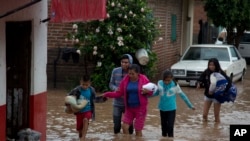Patricia degraded from one of history's most powerful hurricanes to an ordinary low-pressure system over northern Mexico, the U.S. National Hurricane Center said Saturday, leaving surprisingly little damage in its wake and posing little threat beyond continued heavy rain.
What came ashore as the strongest storm ever recorded in the Western Hemisphere dropped to a Category 1 storm by morning, then dissipated further by midday, with maximum sustained winds of just 45 kph (28 mph), according to the hurricane center.
The hurricane's most powerful punch hit a sparsely populated stretch of Mexico's Pacific Coast before the system crashed into mountains that sapped its force. The popular beach city of Puerto Vallarta and the port of Manzanillo were spared the brunt of the violent weather.
There were no reports of deaths or injuries, said Roberto Lopez Lara, interior secretary for Jalisco state. It was a remarkable outcome, considering that Patricia had been a Category 5 hurricane with winds up to 325 kph (200 mph) before it came ashore Friday with slightly less power in an area dotted with a few upscale hotels.
Hours later, as the storm spun inland, it collapsed into fast-moving bands of rain aimed at already sodden Texas.
Mexican President Enrique Pena Nieto said "first reports confirm that the damage has been less than that corresponding to a hurricane of this magnitude." But he urged people to remain in shelters. Considerable rainfall could produce life-threatening flash floods and mudslides.
Authorities relocated coastal residents, evacuated tourists, and closed seaports and airports as the storm brought surging seas and heavy rain.
U.S. President Barack Obama said American disaster aid experts were on the ground and ready to offer help.
Patricia's power while still out at sea was comparable to that of Typhoon Haiyan, which left more than 7,300 dead or missing in the Philippines two years ago, according to the U.N.'s World Meteorological Organization.
Some information for this report came from AP.












